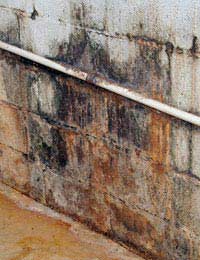Loft Conversion, How Can I Rid Damp and Mould?

Q.
We had our loft converted into a bedroom 17 years ago. All was fine but now the walls are getting very damp & mouldy.
What can I do to rectify the situation and how much will it cost?
A.
Damp and mould are normally caused by cold weather mixed with rainy or dry conditions. It normally surfaces in places where there is little air or ventilation, so any excess moisture becomes trapped and can turn to damp.
It often likes to appear in corners or on windows and in places that are hidden, so lofts are an ideal breeding ground for it.
In order to prevent damp and mould you must first find its cause. Check that there are no leaking pipes or water such as rain getting into your loft through any hidden holes.
The water could be coming in through a loose slate on the roof or a blocked gutter.
You should check your loft's damp proof course is working properly. A damp proof course is a large piece of fabric that is inserted into the building to stop water from moving about and rising up from the ground. If you don't know if you have damp proofing contact a local loft specialist or builder and get them to asses whether you have this. You can get damp proof cause installed for anything between £500-£2,000 depending on how big your loft is.
If you have recently had your house plastered or some building work done it could be that this did not dry out properly and the rain caused it to go damp.
If you have very bad damp and mould it may be a good idea to buy a dehumidifier which will help dry your home out, you should be able to pick one of these up for between £50-£200.
The first thing to do is not to cram things in too tightly in your loft, make sure there is plenty of room between things you are storing or any furniture as this will also help to let air get to the damp.
You should make sure that your loft is insulated and damp proofed, contact your local council as they might be able to offer to do it at a reduced rate. It will normally cost a couple of hundred pounds if you are just getting your loft done. Cavity wall insulation can also help to cut down on damp and mould along with double-glazed windows.
Hopefully these measures should help prevent mould in the first place but if mould does keep appearing you can help remove it by cleaning down walls and window frames with a fungicidal wash, which you should be able to buy from a local DIY shop and should cost less then £10.
Once you have got rid of the mould you will need to paint or decorate over the exposed areas with a special fungicidal paint to stop any reappearing.
You should then try and avoid using normal paint or wallpaper over the decorated area or this will make all your efforts ineffective.


Re: Guidelines for Basement Regulations
Regarding my place of work, the property includes basement level offices with a fire escape door into the external…
Re: Getting Funding for Your Loft Conversion
I’m looking at converting our bungalow loft to give us extra space so we can look into fostering.
Re: Guidelines for Basement Regulations
Does anyone know if there are any regulations covering the use of timber stairs in basments
Re: Guidelines for Basement Regulations
My friend and her 2 year old son have been put in a basement for emergency housing. It has no windows and only means of…
Re: Getting Funding for Your Loft Conversion
So I rent my appointment from a private landlord, it was completely rin down when I first moved in, having come…
Re: Top Tips for Flooring Your Loft
What a great article. Thank you for sharing
Re: Getting Funding for Your Loft Conversion
Hi ya I live in a 2 bed house with my 3 boys. Eldest is nearly 12. In a few years the youngest who's 3 will need to…
Re: Top Tips for Flooring Your Loft
Quite interesting, excellent work, and many thanks for sharing.
Re: Top Tips for Flooring Your Loft
I'm delighted to say that it's a fascinating article to read
Re: Getting Funding for Your Loft Conversion
I currently have a adult person thats disabled and have two children one special needs autistic and adhd and…